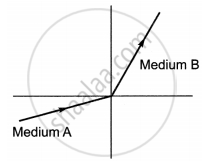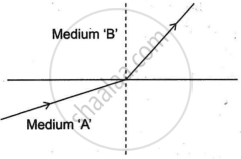Advertisements
Advertisements
प्रश्न
A ray of light travelling in air goes into water. The angle of refraction will be:
(a) 90°
(b) smaller than the angle of incidence
(c) equal to the angle of incidence
(d) greater than the angle of incidence
उत्तर
smaller than the angle of incidence
Because when a light ray passes from a rarer medium to a denser medium, it bends towards the normal.
APPEARS IN
संबंधित प्रश्न
The absolute refractive indices of two media 'A' and 'B' are 2.0 and 1.5 respectively. If the speed of light in medium 'B' is 2 × 108 m/s, calculate the speed of light in:
(i) vacuum,
(ii) medium 'A'.
Find out, from Table, the medium having highest optical density. Also find the medium with lowest optical density.
| Material medium | Refractive index | Material medium | Refractive index |
| Air | 1.0003 | Canada Balsam | 1.53 |
| Ice | 1.31 | – | – |
| Water | 1.33 | Rock salt | 1.54 |
| Alcohol | 1.36 | – | – |
| Kerosene | 1.44 | Carbon disulphide | 1.63 |
| Fused quartz | 1.46 | Dense flint glass | 1.65 |
| Turpentine oil | 1.47 | Ruby | 1.71 |
| Benzene | 1.50 | Sapphire | 1.77 |
| Crown glass | 1.52 | Diamond | .42 |
You are given kerosene, turpentine and water. In which of these does the light travel fastest? Use the information given in Table.
| Material medium |
Refractive index | Material medium | Refractive index |
| Air | 1.0003 | Canada Balsam | 1.53 |
| Ice | 1.31 | – | – |
| Water | 1.33 | Rock salt | 1.54 |
| Alcohol | 1.36 | – | – |
| Kerosene | 1.44 | Carbon disulphide | 1.63 |
| Fused quartz |
1.46 | Dense flint glass |
1.65 |
| Turpentine oil | 1.47 | Ruby | 1.71 |
| Benzene | 1.50 | Sapphire | 1.77 |
| Crown glass |
1.52 | Diamond | 2.42 |
Refractive indices of carbon disulphide and ethyl alcohol are 1.63 and 1.36 respectively. Which is optically denser?
The refractive index of glass for light going from air to glass is The refractive index for light going from glass to air will be:
(a) `1/3`
(b) `4/5`
(c) `4/6`
(d) `5/2`
n = _______. This law is also called as Snell’s law.
Solve the following example.
Speed in first medium, v1 = 3 × 108 m/s
Speed in second medium, v2 = 2 × 108 m/s
Then 2n1 = ?
A light ray enters from medium A to medium B as shown in figure. The refractive index of medium B relative to A will be ______.

A light ray enters from medium A to medium B as shown in the figure.

If the speed of light in medium A is `v_a` and in medium B is `v_b`, what is the refractive index of B with respect to A.
| The ability of medium to refract light is expressed in terms of its optical density. Optical density has a definite connotation. It is not the same as mass density. On comparing two media, the one with the large refractive index is optically denser medium than the other. The other medium with a lower refractive index is optically rarer. Also the speed of light through a given medium is inversely proportional to its optical density. |
- Determine the speed of light in diamond if the refractive index of diamond with respect to vacuum is 2.42. Speed of light in vacuum is 3 × 108 m/s.
- Refractive indices of glass, water and carbon disulphide are 1.5, 1.33 and 1.62 respectively. If a ray of light is incident in these media at the same angle (say θ), then write the increasing order of the angle of refraction in these media.
- (A) The speed of light in glass is 2 × 108 m/s and is water is 2.25 × 108 m/s.
(a) Which one of the two optically denser and why?
(b) A ray of light is incident normally at the water glass interface when it enters a thick glass container filled with water. What will happen to the path of the ray after entering the glass? Give reason.
OR
(B) The absolute refractive indices of glass and water are 4/3 and 3/2, respectively. If the speed of light in glass is 2 × 108 m/s, calculate the speed of light in (i) vacuum (ii) water.
